
Publisher:
Bonnie King
CONTACT:
Newsroom@Salem-news.com
Advertising:
Adsales@Salem-news.com

~Truth~
~Justice~
~Peace~
TJP
Dec-27-2012 21:16

 TweetFollow @OregonNews
TweetFollow @OregonNews
Drought Response Workshop Held In Orange County CA
Roger E. Bütow ODD MAN OUT Salem-News.comAre Water Supplies in California Headed For A Resource Cliff?
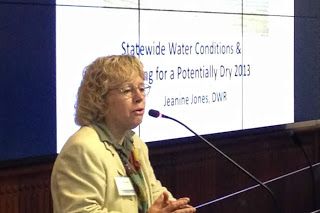 Jeanine Jones of the Department of Water Resources helped organize the workshop and spoke on statewide water conditions. |
(LAGUNA BEACH, CA) - The all day Drought Response Workshop (DRW) was organized by the California Department of Water Resources and National Water Research Institute. It was held on November 6, 2012 in Fountain Valley at the offices of OCWD.
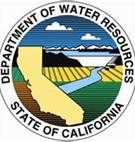
"The purpose of the Drought Response Workshop was to review and provide updates on drought planning, response, and mitigation measures. It was intended for water agencies and other public and local agencies involved in drought response and planning efforts. Over 70 people attended this workshop, which offered CEUs from the California Department of Public Health." Source: NWRI website
Like it's predecessor and cousin (the CalDesal 1st Annual Desalination Conference one week prior), the DRW provided cutting edge updates, reports, retorts and detailed analyses by regulatory agencies, water and utility district staff plus world class experts. All of the speakers took questions, all were very open and non-judgmental about inquiries from the gallery.
I'm one of those who believes in climate change but is uncomfortable with the phrase "global warming." That seems too simplistic and doesn't really confront the cyclical variations or nuances that we as relatively short-lived mammals have chronicled. We only started keeping track, that is writing down anecdotes that could be scientifically valuable, in the past few thousand years ago---So our view, our statistics or understanding of cycles is mostly based on carbon dating, tree rings, fossils, etc.

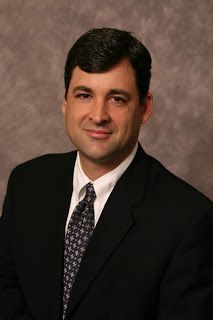 NWRI Executive Director since 2005, |
Below is a link that the NWRI has kindly provided, it lets browsers read the actual Power Points® given by workshop presenters. I have posted many of what I feel to be pertinent and highly educational slides in this article.
I wish they'd placed the Q & A banter online verbatim too, because a lot of interesting information was exchanged due to the technical expertise of the audience. Just like the CalDesal Conference, no punches were pulled, nobody bobbed and weaved, no rope-a-dope, nobody was censured or ignored: http://nwri-usa.org/drought.htm
Let me reiterate a point I've been trying to hammer home to the eco-protectionists (enviros) in this field: Non-governmental public advocacy groups (NGOs) shouldn't stay stuck on the dime of "NO!" when they don't know. Ignorance might be bliss but it doesn't help solve the problems we're facing. This adds fuel to the charges coming from across the negotiating table that we're ignorant, obstructionists, or both.
Ongoing, continual updating and monitoring plus attendance at venues like this have tremendous value if enviros availed themselves. Self-education, especially regarding latest water supply strategies, attendant regulatory oversight and emerging beneficial technologies, are important. Being cynical or skeptical without the insights of integrated critical thinking is counter-intuited.
What's occurring in real time is the establishment of a diversified water portfolio, and similar to a stock market concept, this is not only where we are, where we're investing time and money, but where we're headed as a state, as a nation and as a world. Reliable water is arguably THE most critical common element to sustain our lives and keep both economies and countries stable.
And hey, it was a free gig, continental breakfast and lunch included, you can't beat that for availability and expense. With increased demand for both potable (drinking) and non-potable (landscape and agricultural irrigation) reliable and sustainable water supplies comes dilemmas never encountered before in Southern California.
Oftentimes, Northern Califiornia gets their fair average share of rainfall, as it is now around Christmas of 2012. We live here in the South, in what Marc Reisner so accurately phrased a Cadillac Desert, at the mercy of taking from other regions lakes and watercourses---Many times to the excessive detriment of their aquatic and riparian ecosystems.
At this venue I found myself to be the only attending and engaged NGO leader----again. There's a trend or statement about enviros in there somewhere. This is very frustrating, realizing that your eco-constituents reserve the right to have an opinion about things they refuse to investigate more in depth. Worse, I serve unpaid while they are on the 501 c 3 dole.
BACKGROUND PERSPECTIVE:
State and federal agencies disagree only slightly over just how much California's general population will grow by 2020. Last figures available were based on the 2010 census, but a 15% increase by 2020 is a good ballpark estimate for our purposes.
Population increase curves are integral in projections of resource demands, as are the drivers, the changing conditions and availability.
Scientists themselves often disagree due to cyclical and demographic variations and fluctuations. According to a Science Magazine column (Volume 321, August 2008) regarding assessments of seasonal forecasts: "....of the dozens of forecast techniques proffered by government, academic and private sector climatologists all but two are virtually useless...about the only time they had any success predicting precipitation was for winters with an El Niño or La Niña." Livezey and
Timofeyeva, BAMS
California's population was estimated at 33 million in 2000, and by 2020 it will be 44 million. Potentially that's an anticipated 1/3 increase in demand that may not be met by available water supplies, regardless of the gamut of strategies being pursued or eventually implemented.
 |
| Population Growth Areas |
Despite what many magical thinkers in the activist community believe, my conclusions are different than theirs. They propose that increased recycling, increased reclamation from wastewater, coupled with efficiency and conservation will do the trick, oh, and aggressive enforcement at local levels, you know, a sort of wandering neighborhood watch, water police watchdog state of affairs.
I've spent a lot of online research, attended a lot of water and sanitation district meetings and conferences these past 15 years. They've been doing their jobs of futuristic planning, it comes back to finite resource limitations and an infinite population growth curve.
We're in a lifeboat, and water, especially drinking water, is NOT a completely renewable resource or ration aboard in abundance.
As I've noted before, there is great potential in wastewater reclamation. However, that requires billions of investment dollars on a statewide level to upgrade our treatment plants to achieve drinking water (advanced tertiary) standards. And before we blame the water and sanitation districts, keep in mind the regulatory hurdles they must overcome to comply with the applicable standards. The State of California proclaims the need but leaves antiquated hurdles and restraining regulations that bog things down.
In the present state of our economy, where will the money come from? Yes, water and sanitation districts have enormous assets, but if they liquidated those assets and used the funds to purchase more land, build out the existing facilities, upgrade all of their infrastructure, theoretically they'd be broke with no funds in the kitty. One horrendous emergency and the unthinkable dystopia could happen: Bankruptcy and chaos.
The ratepayers would cry havoc and scream holy hell because rates would HAVE to go up tremendously to replenish, to subsidize future expenditures. This would be fiscal suicide, yet droughts and their unpredictability are a clear and present danger, regard this graphic from 20th Century databases for the USA:
 |
| Source: Dr. S. Sooroshian's Center for Hydrometeorolgy & Remote Sensing (CHRS) |
After attending the DRW, I think that we're on the verge of having tightened our belts pretty far and perhaps one more ratcheting notch is possible. We should probably just assume a worst case scenario and live each day as if in the middle of a drought cycle. Maybe another 10% of use reduction across the board for both irrigation and drinking water can presently be achieved. We've made tremendous headway but the conservation limit event horizon is looming.
Necessity being the mother of invention, people are planting more drought tolerant, zero or xeri-scape (native) landscapes everywhere. Some give up, put down synthetic turf or pave over their yards. Which is kinda stupid because these surfaces heat up like crazy, creating mini heat islands. This forces people into turning their AC (you guessed it) on more frequently and increases their carbon footprint. It's like putting a furnace in your yard, what else do you expect? Some trade-off, huh?
Unfortunately, impervious surfaces not only lessen subsurface groundwater (aquifer) recharging, a vital resource for future extraction and reuse, but the surface moisture content vital to those life-sustaining trees with their outward-reaching root systems. Tree canopies lower temperatures, provide shade for bushes and also provide habitat for various animal species. The roots help stabilize soil, lowering erosive effects and lessening slide potential on slopes.
"A single mature tree can absorb carbon dioxide at a rate of 48 lbs./year and release enough oxygen back into the atmosphere to support 2 human beings."- McAliney, Mike. Arguments for Land Conservation: Documentation and Information Sources for Land Resources Protection, Trust for Public Land, Sacramento, CA, December, 1993
Because of the increased impermeable surfaces and increasing solar gain (heating effect) you get lower oxygen values in your vicinity---And the runoff volumes are greater when it rains, thus contaminants migrate, piggy-back on the spillover. Impervious pavement==Pollution. So I'm not a big fan of artificial replacement---Buffalo grass needs only 20% of the same volume and fulfills basic aesthetic and biotic needs.
We are using irrigation system devices that sense soil moisture content, and will not pressurize sprinklers if adequate. One Best Emerging Technology (BET) ties parcels as small as individual residences into the web, and if substantial rain is anticipated soon, or beginning to fall, once again the valve station's computer shuts things off.
Water efficient devices, water conservation, tiered water rates (the more you use the more you pay per gallon), and massive amounts of public education programs have spent great sums and made a difference these past 10 years. And speaking of predictability, this slide from Dr. Soroosh Sorooshian's presentation regarding our Canadian neighbors divulges graphically the limitations of taking polaroids, that is mere snapshots of our climate and trying to squeeze reliable, long term future models out of them:
The overwhelmingly vast majority of public agency presentations at the DRW provided legitimate databases that reflect 50%-60% less is being used by their local So Cal clients as compared to the year 2000. That's not been widely understood, integrated, publicized and comprehended by critics. Someone is always trying to shove the fickle finger of fate, or at least point it, at a public agency----Scapegoats are easy targets, just ask Pogo.
Anti-water and sanitation NGOs, the harshest critics, keep repeating the same lies: That these agencies operate in stealthy undisclosed and semi-criminal regions, never post hearing notifications, that they continually breach transparency regulations, often circumvent or ignore so-called "sunshine laws" we call The Brown Act in California. Nothing could be further from the truth----The public just doesn't bother to look for notifications, attend meetings or track projects that affect them.
These cities, counties, water and sanitation district providers are a lot more clever, a lot thriftier than portrayed, a lot more progressive and unappreciated. They're recovering and capturing or diverting, then filtering, cleansing and reusing available water up to their existing facilities and budget limits. Ironically, they get about a 60% recovery rate by volume rate, very similar to desalination and other extraction analogs.
They now have monitoring capabilities unknown or unheard of only a decade ago, so they've maximized the opportunities to assure delivery. Progress is and will continue it's improving path, whether through better technologies, smarter customers or a combination of the two. Yet once again, we're getting down to basic math, driven by a growing population whether illegally here or not.
And puh-lease, rain barrel catchments in a region like So Cal have a very limited potential function. When the demand is greatest it doesn't rain and dispersion of the captured water is very reliant upon aggressive maintenance and even expensive mini-treatment plants for each dwelling.
We had bomb shelters in the 50s and 60s, now many believe that huge underground cisterns or catchments would work....or give up precious living space in your garage for a humungous holding tank.
Of course they don't mention the operations and maintenance costs to homeowners, let alone capital purchase outlay, plus the increased carbon footprint regarding the electrical demands for pumps and other devices that need high voltage, not low voltage solar power.
Leaves in your gutters and other debris sloughing off of your roof will need constant removal to keep the rain barrels efficient, and then they just sit there all around your house for 9 months or more out of the year. Oh swell.
And really, c'mon, imagine those same rain barrels as vector environs for rats and mosquitos. Can you say West Nile Virus? I knew you could. Ditto for digging holes in your yard or under your house to create the lined subterranean cisterns I noted. They'd also be a good pest medium and require almost constant sterilizing, plus stirring and/or pumping somewhere, anywhere. And retrofitting sub-surface could destabilize not only your home but adjacent down-gradient properties.
If everyone did, one good seismic jolt and in cities like mine with steep hills we'd all have beach front property----If you like being in a communal, slope failure rubbled heap that is.
Early in 2000, everyone in the industry pretty much agreed that residential dwellers each used about 100-125 gallons per day (gpd). The most recent challenge by the State of California Department of Water Resources is their 20/2020 Campaign----A 20% use reduction in 7 years.
So just for fun, let's assume that by then we'll have cut that 100 gpd in half, by 50%==50 gpd/person. Unfortunately, regressing back to our known numbers 20 years prior to that target date, by the year 2020 with our projected population growth, we'll be back where we started a la Groundhog Day...or perhaps like those pitiful hamsters who get busy but go nowhere, in a vicious under-supply cycle.
THE WORKSHOP:
Dr. Soroosh Sorooshian (try saying that 5 times and you'll sound like Sylvester The Cat) was to me by far the most interesting speaker. He spoke right after the buffet lunch, and although he didn't come right out and say it, in a way he obliquely challenged much of the data and opinions previously (and subsequently) presented.
 |
| Dr. Soroosh Sorooshian, Distinguished Professor and Director, Center for Hydrometeorology and Remote Sensing, UC Irvine, spoke on state-of-the-art drought prediction. |
What climate change? What global warming? What predictive modeling? WTF?
"Presently, the accuracy of regional scale climate model predictions fall short of meeting requirements of water resource planning."
Dr. Sorooshian let some blunt honesty, a lot of fresh air (and thinking) into the room, and I couldn't help but wonder that if he'd given his presentation first, the others might have changed their information----or at least couched their assertions in more vague terms if they'd watched a sneak preview of Dr. Sorooshian's assertions in advance. His admission of the ambiguities and uncertainties had me scanning the crowd wishing that I could read minds. Most were probably thinking "OMG, this guy is killing/killed my act."
He did toss us all a tidbit slide, a morsel that was typified as a "trend":
He's definitely become one of my favorite speakers if for no other reason than his courage in that room. It's no wonder his graduate students love him. If Hydrometeorology had a rock star, suit, tie and all, he'd be it. I laughed aloud (alone) several times and realized that his droll schtick was lost on many.
Moving on, a man I'd already seen and heard at the CalDesal Conference, Dr. David Smith Managing Director, WateReuse California, provided some interesting database information in his presentation.
The slide about California Water Facts was of tremendous value to someone like myself, the enormity, the mind-boggling millions of acre feet per year (MAF/Yr) we use was difficult to comprehend.
He admitted that there are several variables expressed as growth scenarios. In addition, when doing Q & A, he adeptly handled several of my questions over the use of reclaimed water, basically low-value irrigation water, to fight fires.
Dave is a graduate of UC Davis, he received a B.S. in Aquatic Ecology and a doctorate in Environmental Engineering. So he brings a highly educated and yet industry savvy portfolio, he's a walking archive and encyclopedia, not some ivory tower academic.
 |
| Dr. David Smith WateReuse California |
My hometown has no infrastructure, no piping to transport what we call Title 22 landscape water to hose down flaming carnages. Our fire hydrants only carry potable---So fire suppression of burning buildings, or open field blazes like the one that nearly burnt us to the ground 20 years ago, in a sense waste our drinking.
Once again cost trumps everything: To dig up, then bury a second series of pipes parallel to our potable lines, repave an entire unplanned community with streets running pell-mell would take milions and millions that no one has. There are no grants in the hundreds of millions of $$$ throughout South OC---besides, EVERY city would justifiably compete for the $$$ if there were, setting city vs. city.
There's an interesting 10 minute interview with David that might be of value to readers: http://www.bcwaternews.com/bcwn/QA/dsmith/dsmith.html
Trends are important, the very basic word "trend" might sound vague but has some value. It helps industry leaders and consultants to convey the potential direction, in a sense the "water vector": Our direction and speed, our momentum towards certain points on the resource/demand graph.
Modeling is the ultimate inexact science, it's always subject to correction, to recalibration with moving targets as subsequent data comes in. If you doubt me, try studying the frustrating US Army Corps of Engineers (USACOE) watershed or National Oceanic and Atmospheric Administration (NOAA) models.
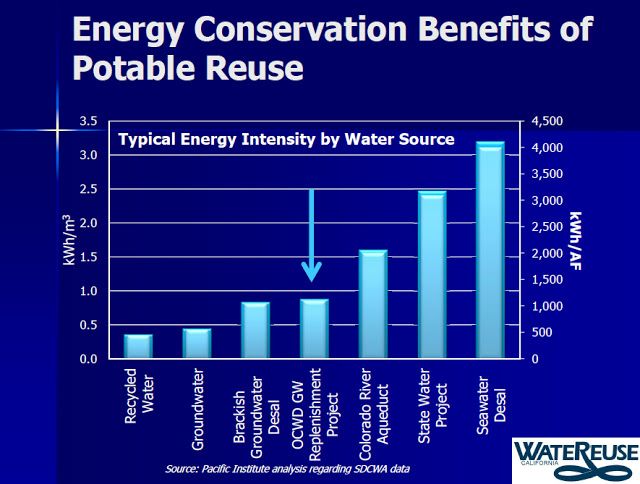 |
They drive me nuts in their ambiguities and many times inaccurate conclusions or projections. The USACOE watershed models have changed about 5 times here in South Orange County since I clocked in some 15 years ago.
One regionally relevant slide at the DRW stood out that helped inform attendees from Orange County about comparative energy demands. Orange County Water District's Groundwater Replenishment Project (which I've written about previously) is about on par with OC's brackish groundwater desalination installations....which I also covered previously.
Importing our water (actually some object and call it theft) from the Colorado River or Northern California costs a lot more energy-wise---We do get more volume, but all of those pumps gobble up the grid. Recycled water costs comparatively little but then again provides little. And you still have higher concentrations of toxin-laden waste via reuse that have to be dumped somewhere watery, polluting, acidifying and contaminating streams, lakes estuaries, and/or the near-tidal portions Pacific Ocean.
That said, Dave's Recycled Water Use Trend slide has some pertinence, it reflects our increased commitment but I'd add our increasing alarm. Everybody says don't hit the panic button, it's never smart to make even short term, let alone long term decisions, in haste-filled fear.
Yet I can't help but feel that we're about to go over a "water cliff" of deficiency like the fiscal fiasco in Washington right now-----Except those career politicians can strike a deal, a compromise about our financial and taxation portfolio. This imminent water resource crash is linear, it's inevitable, looming and perhaps not even preventable.
Unfortunately, if everyone was paying attention, for all of the trending the current and projected usage metrics are pulling away from the supply side potential. It's like a rocket traveling 100 million miles per hour trying to catch another one approaching, moving at the speed of light (700 million miles per hour). Or use that expanding universe concept...we'll never reach the outer fringe because it's not possible.
And our unquenchably thirsty, increasing population growth outstrips our ability to provide. Northern California in the future will need all of their native water, because during droughts they and their ecosystems especially suffer from our pilferage. Our neighboring states that have Colorado River rights are in the same boat. Nevada has grown exponentially, it's been estimated that California is drawing 15% over its intended rights.
And what would these conferences be without Ron Wildermuth? Ron just cracks me up. His style is so casual. It's like he's sitting in your living room slamming down some brewskis, just having a friendly chat.
Ron's formal title is Manager of Public and Government Affairs for West Basin Municipal Water District (WBMWD). He's more like their genial ambassador at large.
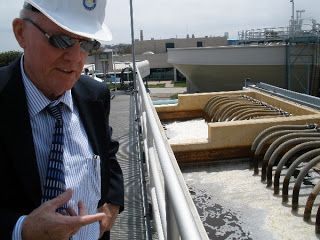
|
one of the filtering tanks at the Edward C. Little Water Recycling Facility
in El Segundo. Credit: Victor Merina
Yet what he conveys in a friendly, almost folksy manner are really critical building blocks of understanding. His enormous district is right there on the cutting edge of reclamation, on desalination and just about everything else under consideration in that water portfolio metaphor I used earlier:
His district has proven that desalination can be installed with almost ZERO ecological damage. That even street sweepers, normally using high value potable, can avail themselves of reclaimed as they do in his domain. His district, like counterparts Orange County Water District and Santa Margarita Water District here in the South OC, is progressive and aggressive. We'll need both.
Instead of fighting the program, Ron seems to see problems as challenges. Instead of whining or grouching, he is the embodiment of an old Chinese aphorism: "A calamity is sometimes an opportunity in disguise." So he's going with the flow, he adjusts, he understands flexible, tactical strategizing.
He never boasts, but an integral aspect of his personal CV reveals the trial-by-fire Ron: "....A graduate of the Naval War College. He served 23 years in the Navy as a Public Affairs Specialist, eventually retiring as a Captain , was an advisor to General Norman H. Schwarzkopf during the first Gulf War."
Source: WBMWD
The general water industry staff, appointed and elected officials, plus their family of consultants and research scientists are making sincere efforts to look out for our future. The men and women I've discussed aren't anomalies: This poorly understood, explored or investigated world is actually plentiful with such creative and innovative personnel.
Maybe it's high time that we in the protectionist field work with, not against them, stop selfishly fighting and begin more mutually beneficial collaborations. The alternatives, that is increasing shortages, confrontations, endless litigation and outright water wars, are frankly unacceptable. Like the adage, you're either part of the water problem or part of the water solution.
http://rogerbutow.blogspot.com/2012/11/clean-water-now-new-beginning-in-2013.html
Please visit: rogerbutow.blogspot.com
FYI: If a project near you has some interesting enviro-aspect(s) that you think is/are worthy of Salem-News.com coverage and our readers attention, feel free to contact me with a very brief synopsis. Water-related “Blue Interventions” are my specialty!
 Launched in 2010, Odd Man Out is the creation of Roger Bütow and his OMO columns are written exclusively for Salem-News-com. Born and raised in the LA Harbor area, son of a German immigrant father, he moved to Orange County in 1965 and has lived in Laguna Beach since 1972. In 1998, he began his professional career in environmental review processes (CEQA, NEPA, MND, MND and EIR/EIS). He's a rare mix of cross-trained builder, writer and consultant as he brings his extensive construction experiences dating back to 1972 into his eco-endeavors. He has tremendous field and technical expertise in successful watershed restorations, plus wastewater, urban runoff,
Launched in 2010, Odd Man Out is the creation of Roger Bütow and his OMO columns are written exclusively for Salem-News-com. Born and raised in the LA Harbor area, son of a German immigrant father, he moved to Orange County in 1965 and has lived in Laguna Beach since 1972. In 1998, he began his professional career in environmental review processes (CEQA, NEPA, MND, MND and EIR/EIS). He's a rare mix of cross-trained builder, writer and consultant as he brings his extensive construction experiences dating back to 1972 into his eco-endeavors. He has tremendous field and technical expertise in successful watershed restorations, plus wastewater, urban runoff,
View articles written by Roger Butow Read Roger's full biography on the Salem-News.com Staff Page
His resumé is extensive, try an online GOOGLE search of his personal journey and historical accomplishments. His consultation fees are reasonable and if you've got a major project that alarms you, that needs creative intervention, then he's your man. His credentials and "CV" can be provided upon request.
Contact him at his office: (949) 715.1912 or drop him an email: roger@clean-water-now.org
 |
 |
 |
Articles for December 26, 2012 | Articles for December 27, 2012 | Articles for December 28, 2012
Salem-News.com:




googlec507860f6901db00.html
Terms of Service | Privacy Policy



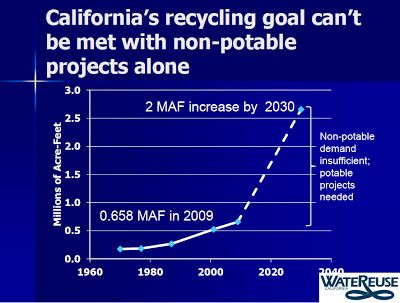





All comments and messages are approved by people and self promotional links or unacceptable comments are denied.
[Return to Top]
©2025 Salem-News.com. All opinions expressed in this article are those of the author and do not necessarily reflect those of Salem-News.com.